ORIF, one load sharing plate
1. Principles
The ideal line of osteosynthesis in the body region runs at the tooth apices' vertical height from the canine region to the oblique line. The line carries into the oblique ridge, which turns into the anterior outer rim of the ramus.
This line is located directly underneath the mucogingival sulcus that can be exposed with ease. The bone thickness of the lateral cortex varies between 6 and 8 mm approximately. Therefore, monocortical screws should be less than 6 mm long to avoid injury to the tooth roots.
The single plate fixation method is contraindicated in the anterior mandibular body because of the rotational/torsional forces in that area that must be neutralized. Two miniplates should be applied to neutralize those forces.
In the posterior transition to the angle and ramus, a second plate just below the oblique ridge may be advantageous in reduced bone stock (eg, a removed impacted wisdom tooth) or significant fracture displacement.
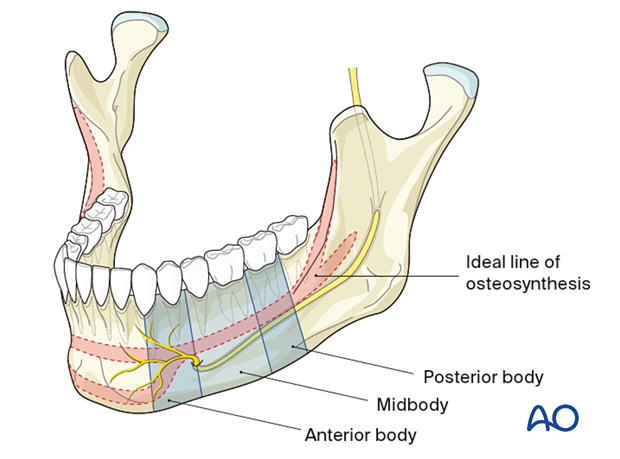
Special considerations
The following special considerations may need to be considered:
2. Patient preparation
This procedure is typically performed with the patient placed in a supine position.

3. Selection of approach
These fractures can often be approached and treated through the transoral approach (combined with the transbuccal system when necessary).

Depending on fracture severity, the difficulty of fixation, and/or the presence of a suitable laceration, a transcutaneous approach through the submandibular route may be indicated.
An advantage of a transcutaneous approach is that it offers an opportunity to place a bone clamp and visualize the lingual cortex reduction.

4. Reduction
MMF
MMF should be obtained through one of the various means available.
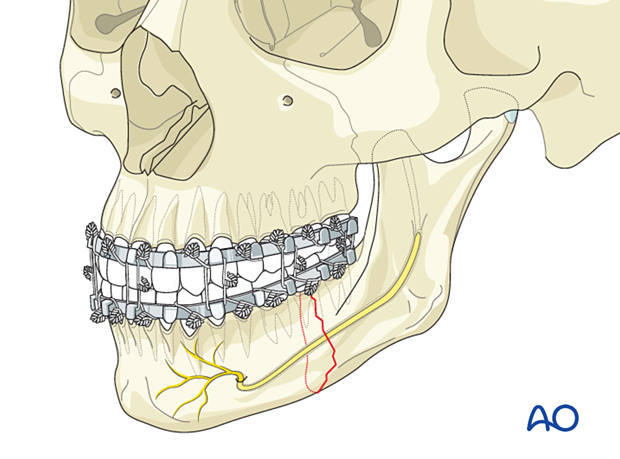
Reduction
Reduction with a conventional bone clamp can be problematic in the posterior region. The clamps can be applied into predrilled holes in the outer cortex that do not interfere with later plate placement.

5. Fixation
Choice of implant
A variety of low-profile mandibular implants can be used superiorly with monocortical screws:
- 5- or 7-hole mandible locking or non-locking plate without a center space
- 4- or 6-hole mandible locking or non-locking plate with a center space
A locking plate will provide greater stability.
Further information on:
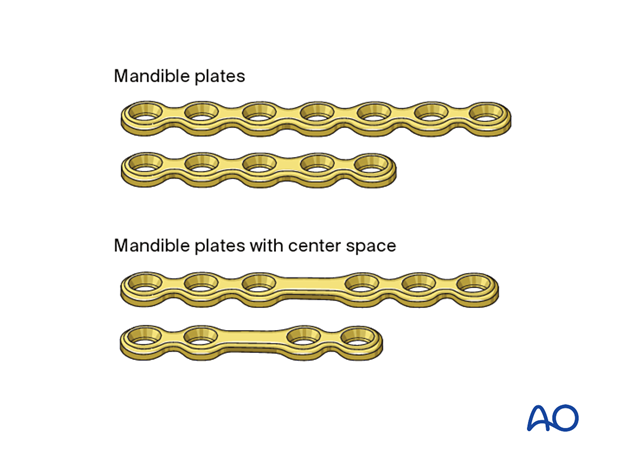
Plate contouring
Contour the plate according to the surface anatomy of the bone.
Check the plate for precise fitting in situ.
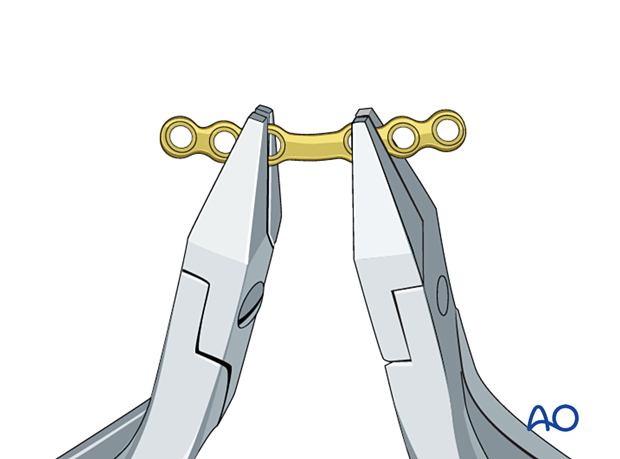
Drill first screw hole
Hold the plate with an appropriate instrument (eg, periosteal elevator or forceps).
Use an appropriately sized drill bit with a 6 mm stop to drill monocortically through the plate hole in the anterior fragment next to the fracture line.
The surgeon should be aware that the outer cortex may be very thin in this region, and damage to the tooth roots is still possible even when using a 6 mm drill bit with stop.

Insert screw
Insert a 6 mm screw. Do not fully tighten it until the final reduction and plate position are confirmed.

Insert the second screw
Insert the second screw in the hole next to the fracture line in the posterior fragment. The periosteal elevator or any other suitable instrument is used to keep the far end of the plate at the correct vertical level.
Tighten both screws.
The clamp can now be removed.
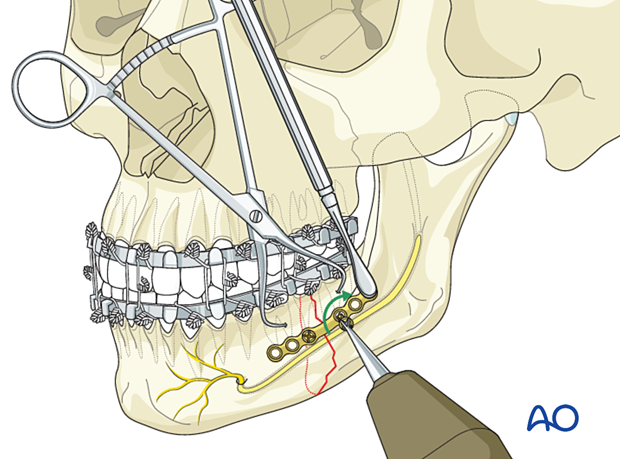
Additional screw insertion
Continue to drill and insert the remaining screws in an alternating fashion working your way away from the fracture line.

Confirmation of reduction
Before wound closure, confirm adequate reduction by assessing the occlusion and inspection of the exposed fracture line.
A splaying of the inferior border of the mandible can be ruled out by further soft-tissue exposure intraoperatively.
A palpable step at the lower border indicates a failed reduction.
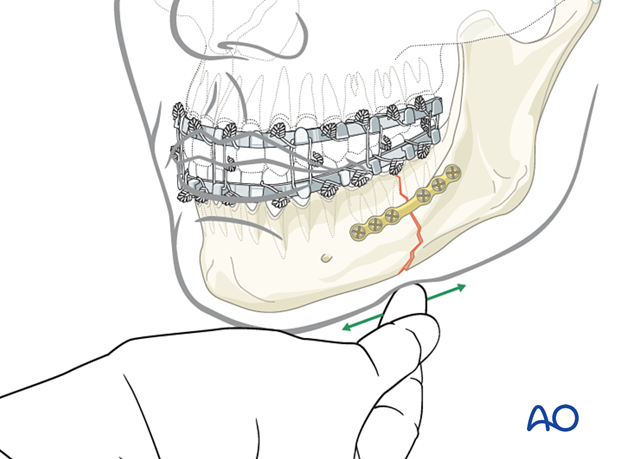
6. Case example
Temporary immobilization
There is a midbody fracture line at the level between the second premolar and the first molar. Ernst ligatures were applied for temporary immobilization of the lower jaw until surgical treatment.

Surgical approach
If arch bars are used, the incision is made more laterally in the vestibule.
However, in this case, since there is a laceration between the second premolar and the first molar, an alternative surgical approach is used. A mucogingival incision in the vestibular sulcus is chosen anteriorly to the injury. In the posterior vestibule, the molars' gingiva is included in the mucoperiosteal flap after sulcular incision.

The longitudinal exposure reaches from the lateral symphysis into the angle region. Two MMF screws are inserted into the maxillary alveolar ridge as anchor points for the wire ligatures. In this case, arch bars were not used as they would interfere with surgical access and closure.

MMF screw application in the lower jaw
The MMF screws in the lower jaw are applied after exposure of the bony surface.
Note the additional fixation of the fracture using an interdental wire loop.

Applying MMF
MMF is applied using MMF screws with wire loops bilaterally.

Choice of implant
A 6-hole medium profile locking plate was selected in this case to provide additional stability.
A 6-hole plate with a span or a 7-hole plate would allow screw insertion further from the fracture line.

Drilling the first screw hole
Drill the first screw hole next to the fracture line in the anterior fragment using a drill bit with a drill stop.

Insertion of the first screw
Insert the first screw.

Insertion of the second screw
After drilling, insert the second screw next to the fracture line posteriorly.

Screw insertion into the most posterior screw hole
The posterior end of the plate is accessible through lip retraction and does not necessitate the use of transbuccal instrumentation.
Retractor tips parallel to instrumentation (not at angles) facilitate exposure with reduced retraction forces on the lips.

Additional screw insertion
The clinical photograph shows all screws inserted.

Checking the occlusion
After checking for correct occlusion, the MMF screws are removed, and the wound is closed.

Completed osteosynthesis
This image shows the AP view of the completed osteosynthesis.
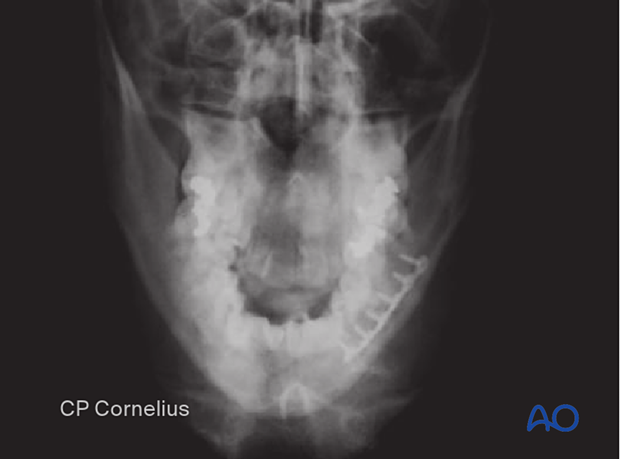
This image shows the lateral view of the same case.

7. Aftercare following ORIF of mandibular symphysis, body, angle, and ramus fractures
Use of jaw bra
If significant degloving of the soft tissues of the mandible has occurred, there may be a consideration for using a jaw bra or similar support dressing.
Arch bars
If arch bars or MMF screws are used intraoperatively, they are usually removed at the conclusion of surgery if proper fracture reduction and fixation have been achieved. Arch bars may be maintained postoperatively if functional therapy is required or if required as part of the fixation.
X-Rays
Postoperative x-rays are taken within the first days after surgery. In an uneventful course, follow-up x-rays are taken after 4–6 weeks.
Follow up
The patient is examined approximately 1 week postoperatively and periodically thereafter to assess the stability of the occlusion and to check for infection of the surgical wound. During each visit, the surgeon must evaluate the patient's ability to perform adequate oral hygiene and wound care and provide additional instructions if necessary. Many patients need to be seen regularly for replacement of their intermaxillary elastics and to encourage range of motion in their TMJ in the later course of the treatment.
Follow-up appointments are at the discretion of the surgeon and depend on the stability of the occlusion on the first visit. If a malocclusion is noted and treatable with training elastics, weekly appointments are recommended.
The patient should be warned to continue routine follow up with their dentist. Fractures near the dental roots can often result in delayed loss of tooth viability, requiring periapical films and additional dental procedures.
Malocclusion
If a malocclusion is detected, the surgeon must ascertain its etiology (with appropriate imaging technique). If the malocclusion is secondary to surgical edema or muscle splinting, training elastics may be beneficial. The lightest elastics as possible are used for guidance, because active motion of the mandible is desirable. Patients should be shown how to place and remove the elastics using a hand mirror.
If the malocclusion is secondary to a bony problem due to inadequate reduction or hardware failure or displacement, elastic training will be of no benefit. The patient must return to the operating room for revision surgery.
Basic postoperative instructions
DietDepending upon the stability of the internal fixation, the diet can vary between liquid and semi-liquid to “as tolerated”, at the discretion of the surgeon. Any elastics are removed during eating.
Patients having only extraoral approaches are not compromised in their routine oral hygiene measures and should continue with their daily schedule.
Patients with intraoral wounds must be instructed in appropriate oral hygiene procedures. The presence of the arch-bars and any elastics makes this a more difficult procedure than normal. A soft toothbrush (dipping in warm water makes it softer) should be used to clean the surfaces of the teeth and arch-bars. Any elastics are removed for oral hygiene procedures. Chlorhexidine oral rinses should be prescribed and used at least three times each day to help sanitize the mouth. Chlorohexidine may cause staining of the teeth and should not be used longer than necessary. For larger debris, a 1:1 mixture of hydrogen peroxide (0.25%)/chlorhexidine (0.12%) can be used. The bubbling action of the hydrogen peroxide helps remove debris. A water flosser, providing a water jet, is a very useful tool to help remove debris from the wires. If a this is used, care should be taken not to direct the jet stream directly over intraoral incisions as this may lead to wound dehiscence.
Physiotherapy can be prescribed at the first visit and opening and excursive exercises begun as soon as possible. Goals should be set, and, typically, 40 mm of maximum interincisal jaw opening should be attained by 4 weeks postoperatively. If the patient cannot fully open his mouth, additional passive physical therapy may be required such as Therabite® or tongue-blade training.














